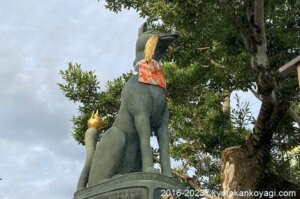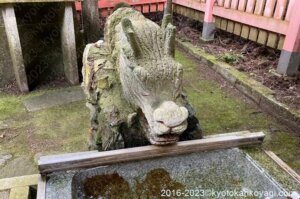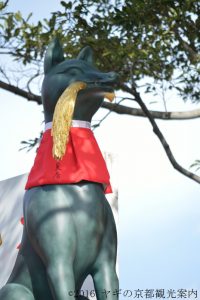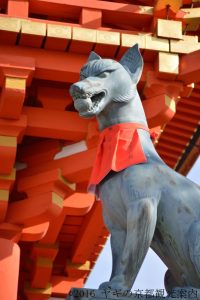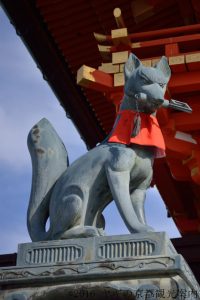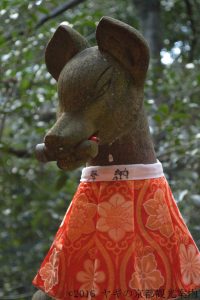Introduction
In Fushimi Inari Taisha shrine, often referred as the Fox shrine in Kyoto, we can find many statues of Foxes, the messenger of the deity enshrined there. In this post, I’ll show you why they are there regarding the deity and in terms of religious syncretism. 合掌

General information of Fushimi Inari


Next post

Fox キツネさん
In ancient Japan, Kitsune was a mysterious animal. When people saw some of them, they expected deities of mountain and rice paddy which gave them fertility.
Sometimes she is equivalent to sur-natural phenomena. Kitsume no Yomeiri (狐の嫁入り) is a good example.
In old days, people often find fire balls called Kaika (怪火) floating in the air. Those days, wedding ceremony was held at night. A Bride left her home to her groom at twilight or night. Her relatives followed her with lanterns. Kaika looked like a fox bride and her relatives.
In addition to it, fox was believed that she was capable of predicting future.
Kenzoku 眷属
Foxes in Fushmi Inari are Kenzoku (眷属). Kenzoku is a animal or creature belongs to a deity. It usually is a messenger of her. Fushimi Inari enshrines Inari no Ohkami (稲荷大神) who is consists of five deities. The most important one is Uka no Mittama no Ohkami (宇迦之御魂大神).
Why did foxes become her Kenzoku? There is a story. A long time ago, there was a fox family that wanted to be good to humans. They decided to go Fushmi Inari and ask Ukano Mittama no Ohkami the way they would take. In the end, she accepted them as her messengers. It is a kind of a fairly tale but there is a more complicated story actually.
In addtion to it, foxes reminded people Yama no Kami (Deity of mountain and Ta no Kami (Deity of rice paddy). People thought their deceased ancestors became Sorei and it takes care of them as a Yama no Kami or Ta no Kami. These Kamis come from and go to each places. Foxes also come from and go to mountains and rice paddies.
Before the foundation of Fushimi Inari Taisha 伏見稲荷創建前
More than two thousand years ago, people believe in snakes as a kind of deity of water and land. This faith of the snake was fused with the faith of the dragon with the arrival of Onmyodo from China and developed into the fatih of Ryuda Shin(龍蛇神), the deity of dragon and snake.
Fushimi Inari is located in the foot of a mountain called Mt. Ianari where the faith was exercised.
In 711, Fushimi Inari was established. Yamashiro no Kuni Fudoki, the report of the culture of ancient Kyoto and other places tells us the the original meaning of “伊奈利 (Inari)”; Hata no Irogu was a prosperous man and he shot a rice cake with an arrow. The rice cake became a swan and she landed the peak of a mountain and the rice plants grew up there.
It says that is the reason of a shrine was named 伊奈利(Rice grows up). To our regret, it doesn’t reveal who the deity is but 伊奈利 and the story implies that she is a deity who has something to do with rice cultivating.
The story reveals why Fushimi Inari does enshrines Uka no Mittama no Ohkami (宇迦之御魂大神). Uka (宇迦) means foods, especially grains. The diet of Japan is rice.
The syncretism of Shinto and Buddhism 神仏習合
Those days, Shinto, or the indigenous belief in nature was fused with Buddhism in Shinbutsu Shugo (神仏習合), the syncretism of Shinto and Buddhism. Uka no Mitama no Ohkami was fused with Dakini Ten (荼枳尼天).
Dakini Ten is originally a deity of land in ancient India. She represents fertility and maternity. In addition to it, she is capable of predicting future.
Fox was considered of a Kenzoku of Dakini Ten due to these features; Fertility, the ability to foresee future.
Uka no Mitama no Ohokami was regarded as Dakini Ten in Shinbutsu Shugo and fox became her Kenzoku.
The things the foxes have in the mouth キツネさんが咥えているもの
Rice plant 稲穂
Fox is a messenger of Uka no Mitama no Ohkami who is a deity of rice cultivating. Many foxes have rice plants.
Hoju 宝珠
The globe stands for the fertility that Inari no Ohkami gives to us.
Key 鍵
With the key, we can have the assistance from the deity. The key also means that of storehouse of rice.
Hand scroll 巻物
In ancient times, we recorded documents and pictures. The key and the globe stands for yin-yang which generates the wisdom. It is written in the hand scroll.
About Fushimi Inari Taisha
Access to Fushmi Inari Taisha
JR Line
Get off train at Inari station. Local line only.
Keihan Line
Get off train at Fushimi Inari station. Express, Local and Sub-express line only.
ヤギの京都観光案内/KYOTO GOAT BLOGをもっと見る
購読すると最新の投稿がメールで送信されます。


